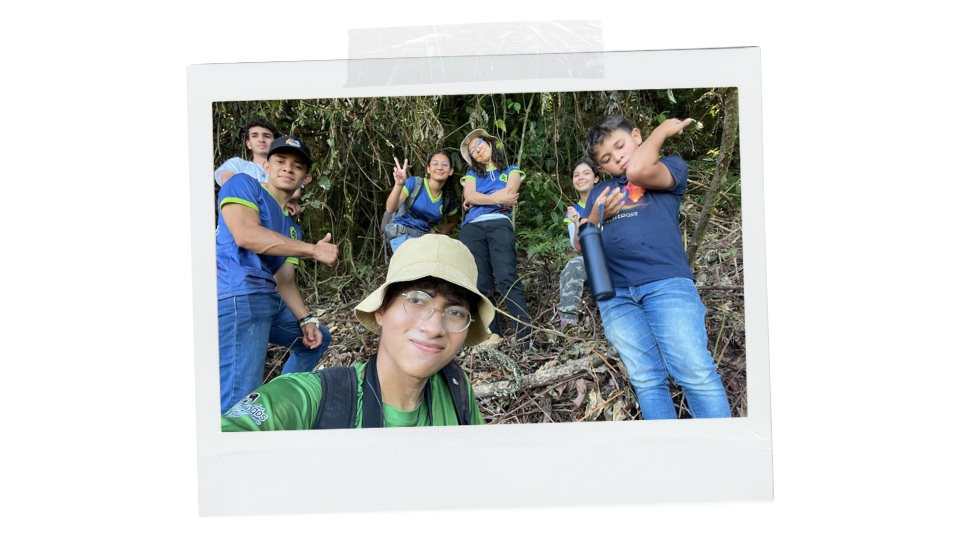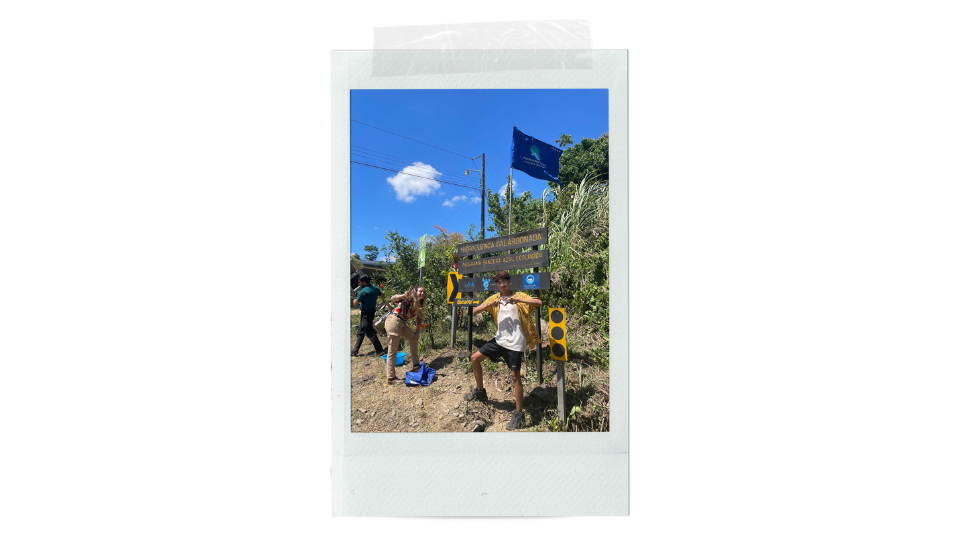Impact of Refugio de Aves
My experience during the past 2 months has been filled with many adventures, but also filled with vast amounts of understanding of initiatives and progression to combat climate change, achieve sustainability goals, and advance cross collaboration in the ecotourism sector. All these examples and stories have inspired me to pursue a nature filled future and to maintain the health and wellbeing of the community and wildlife that lives near and around us.
Monteverde and Tropical Scientific Center Initiatives
The management of Monteverde’s Cloud forest was extraordinary. And during my stay there, I was able to learn about the projects it has carried out throughout its 50+ year lifespan. One of them was Quetzal counting. It was interesting to listen to the methods they use, from standing in one location for 15 minutes in order to identify one Quetzal, and then moving another 100 meters to another location to conduct the same experiment. All in all, in total there have been 200 registered Quetzales in the forest, and the amount has been healthy and steady the past decade. However, this is not to say it is an easy feat to spot a Quetzal, it took me well over 6 hours in the forest identifying snakes, monkeys, trogons, etc., only for when I was about to exit the forest did I spot it—its majestic colors and long tail flying through the air. It was one of my aspirations in Costa Rica, and now I have fully achieved it.
An interesting experience while at Monteverde was how the Bellbird was not a native species to the Monteverde forest as the conditions do not suit it. However, due to climate change, it is a rare sighting in the reserve. This goes along with the second project of Monteverde, which is climate research with the National University of Costa Rica and various international organizations to figure out the impact of changing climates on the cloud forest, animal behaviors, and biodiversity effects. Going hand-in-hand with these changes is the tourists’ impact on the wildlife and ecosystems in Monteverde, and as a whole in Costa Rica, where tourism is high and animal behavior has shifted. This is the case at Manuel Antonio and Guanacaste, with monkeys robbing belongings in exchange for food, and it has been noted in the Cloud Forest that animals within 50 meters of the trails have experienced some behavioral changes in contrast to those 100 meters away from the trails which have close to no impact.
Another investigation project that Monteverde and CCT have carried out, was identifying animals in the forest refuge San Luis, a private reserve only open to researchers. This amazing opportunity allowed me to see 3/4 of CCT-managed organizations and how they strive to make each one a sustainable haven for animals and nature.
Community Initiatives and Achievements
Ecological Blue Flag program
The Peñas Blancas River has achieved a 5-star rating from the Ecological Blue Flag Program, a milestone for the CoBAS community and a reflection of the community’s sustainability efforts. Before coming to Costa Rica, I had little insight into the purpose and significance of the Ecological Blue Flag Program, but after coming into contact with the community’s achievements, it has shown me how much it means to the community to feel honored and respected for their hard-work.
The Brigada
The Brigada, made up of local community members to propel conservation efforts, has received terrible news. This year, funding has been limited due to a lack of institutional sponsorship. As a result, they have to navigate this year in a new trajectory. However, they have managed to overcome this obstacle by being resourceful with current equipment and cross-collaboration. What was a first for me, was placing camera traps with the Cedral community and AltaGracia resort in order to capture the animals that live within the corridor. A mission that was no easy task-as we had to hike countless miles to find a suitable environment that captures a myriad of animals. All the while taking note of the route, coordinates, and camera settings. Additionally, we managed a Recycling campaign in Quizarra with the help of the Municipalidad, which resulted in one of the most successful campaigns they’ve had!
In the recent months, finca owners from around the Biological Corridor Alexander Skutch have come together to form ecotourism travel packages in order to expand its network of operations and advance its business. What excites me the most about this is the cross-collaboration and effort to uplift one another. I was able to give my advice as a foreigner on prices and product offerings. From trail walks, sugar cane factories, cacao production, and local coffee to cloud forests, each has added a bit of life and diversity into the packages.
Impacto y organización de Refugio de Aves
Mi experiencia durante los dos últimos meses ha estado repleta de aventuras, pero también de conocimientos sobre iniciativas y avances en la lucha contra el cambio climático, el logro de objetivos de sostenibilidad y la colaboración en el sector del ecoturismo. Todos estos ejemplos e historias me han inspirado a perseguir un futuro lleno de naturaleza y a mantener la salud y el bienestar de la comunidad y la fauna que vive a nuestro alrededor.
Iniciativas de MonteVerde y el Centro Científico Tropical
La gestión del Bosque Nuboso de Monteverde fue extraordinaria. Y durante mi estancia allí, pude conocer los proyectos que ha llevado a cabo a lo largo de sus más de 50 años de gestión. Uno de estos proyectos fue el conteo de Quetzales. Fue interesante escuchar los métodos que utilizan, desde pararse en un lugar durante 15 minutos para identificar un Quetzal, hasta desplazarse otros 100 metros a otro lugar para realizar el mismo experimento. En total, se han registrado 200 Quetzales en el bosque, y la cantidad ha sido constante en la última década. Sin embargo, esto no quiere decir que es una hazaña fácil de ver un Quetzal, me tomé más de 6 horas en el bosque identificando serpientes, monos, trogones, etc. – y cuando estaba a punto de salir del bosque lo vi – sus colores majestuosos y larga cola volando por el aire. Era una de mis aspiraciones en Costa Rica, y ahora lo he conseguido plenamente.
Una experiencia interesante durante la estancia en Monteverde, fue ver que el pájaro campana no es una especie autóctona del bosque de Monteverde, ya que las condiciones no se adaptan a él. Sin embargo, debido al cambio climático, es raro verlo en la reserva. Esto va de la mano con el segundo proyecto de Monteverde, que es la investigación climática con la Universidad Nacional de Costa Rica y varias organizaciones internacionales para averiguar el impacto del cambio climático en el bosque nuboso, los comportamientos de los animales y los efectos en la biodiversidad. A estos cambios se une el impacto de los turistas en la fauna y los ecosistemas de Monteverde y de toda Costa Rica, donde el turismo es elevado y el comportamiento de los animales ha cambiado. Este es el caso de Manuel Antonio y Guanacaste, con monos que roban pertenencias a cambio de comida, y se ha observado en el Bosque Nuboso que los animales a menos de 50 metros de los senderos han experimentado algunos cambios de comportamiento – en contraste con aquellos a 100 metros de los senderos que casi no tienen impacto.
Otro proyecto de investigación que Monteverde y el CCT han llevado a cabo, es la identificación de animales en el refugio forestal San Luis, una reserva privada sólo abierta a investigadores. Esta increíble oportunidad me permitió ver 3/4 de las organizaciones gestionadas por el CCT y cómo se esfuerzan por hacer de cada una de ellas un refugio sostenible para los animales y la naturaleza.
Programa de Bandera Azul Ecológica
El río Peñas Blancas ha obtenido la calificación de 5 estrellas del Programa Bandera Azul Ecológica, un gran logro para la comunidad de CoBAS y un reflejo de los esfuerzos de sostenibilidad de la comunidad. Antes de venir a Costa Rica, tenía poca idea de la finalidad y el significado del Programa Bandera Azul Ecológica, pero después de entrar en contacto con los proyectos de la comunidad, me ha demostrado lo mucho que significa para la comunidad sentirse honrada y respetada por su duro trabajo.
La Brigada
La Brigada, formada por miembros de la comunidad local para impulsar los esfuerzos de conservación, ha recibido terribles noticias. Este año, la financiación ha sido limitada debido a la falta de patrocinio institucional. Como resultado, tienen que navegar este año en una nueva trayectoria. Sin embargo, han conseguido superar este obstáculo gracias a su ingenio con los equipos actuales y a la colaboración. Una actividad nueva para mí, fue colocar cámaras-trampa con la comunidad de Cedral y el complejo AltaGracia, para capturar los animales que viven en el corredor. Una misión difícil, ya que tuvimos que recorrer innumerables kilómetros para encontrar un entorno adecuado que permitiera capturar una miríada de animales. Todo ello mientras tomábamos nota de la ruta, las coordenadas y los ajustes de la cámara. Además, gestionamos una campaña de reciclaje en Quizarra con la ayuda de la Municipalidad, ¡que resultó en una de las campañas más exitosas que han tenido!
En los últimos meses, propietarios de fincas de todo el Corredor Biológico Alexander Skutch se han unido para formar paquetes de viajes ecoturísticos con el fin de ampliar su red de operaciones y avanzar en su negocio. Lo que más me entusiasma de todo esto es la colaboración y el esfuerzo por elevarse mutuamente. Pude dar mi consejo como extranjero sobre precios y oferta de productos. Desde paseos por senderos, fábricas de caña de azúcar, producción de cacao y café local hasta bosques nubosos, cada uno ha añadido un poco de vida y diversidad a los paquetes.
—Alejandro



